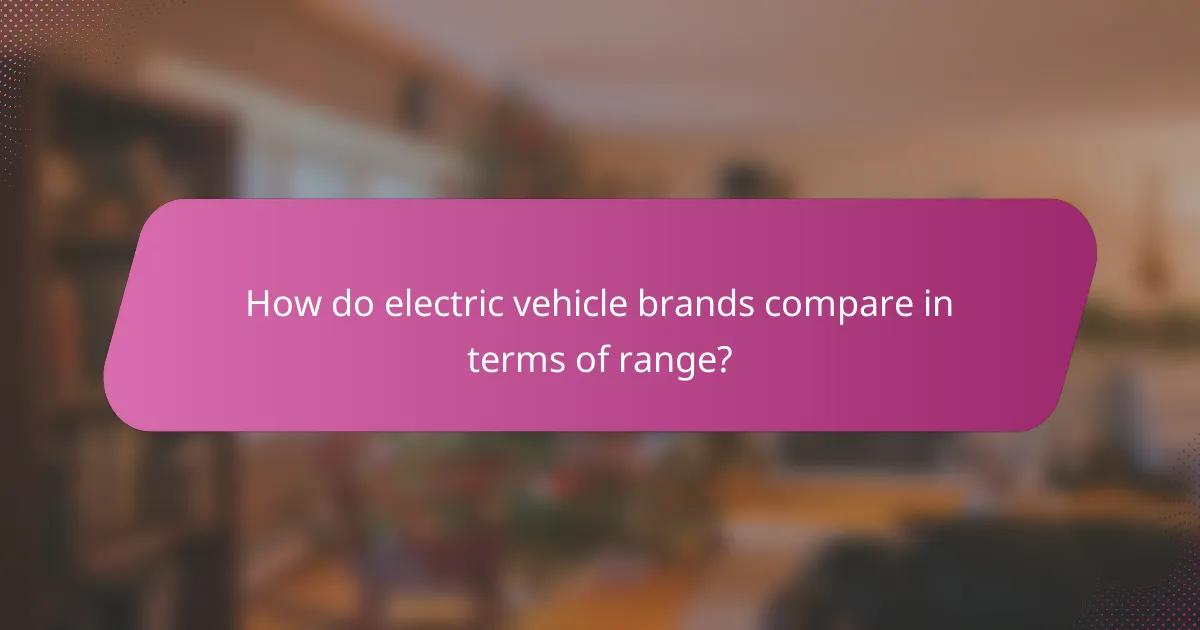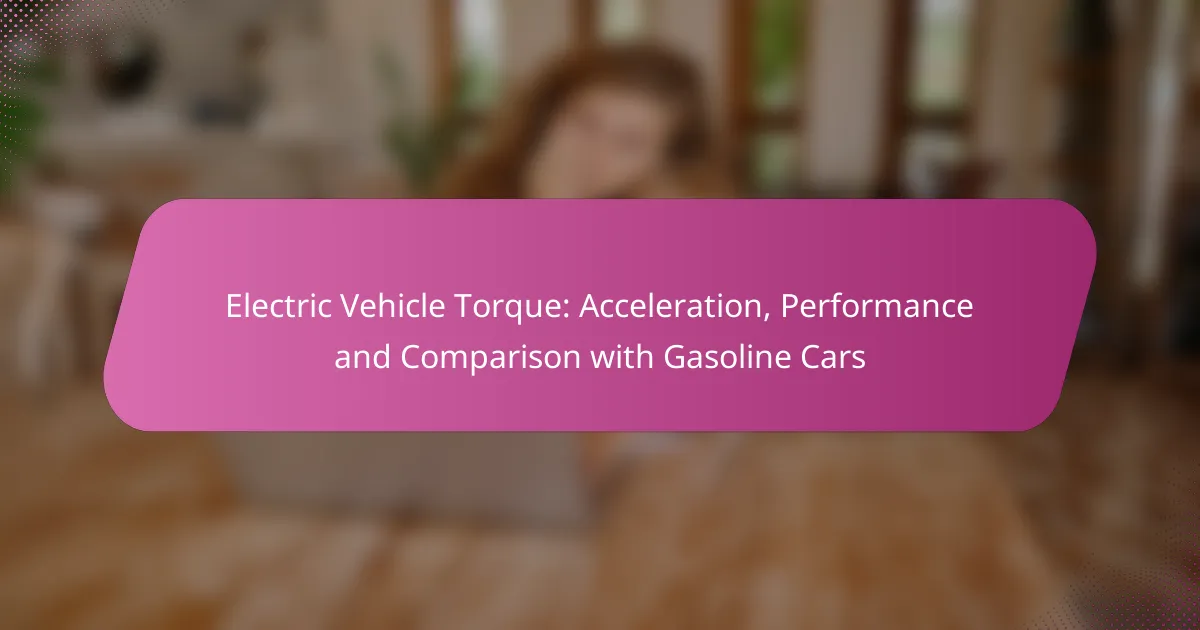The driving range of electric vehicles (EVs) can vary widely, typically falling between 150 and over 400 kilometers on a full charge. This range is influenced by several factors, including battery size, vehicle efficiency, and real-world driving conditions, such as speed and terrain. Understanding these elements is crucial for maximizing your EV’s performance and ensuring you get the most out of each charge.

What is the driving range of popular electric vehicle models?
The driving range of electric vehicles (EVs) varies significantly among popular models, typically ranging from around 150 to over 400 kilometers on a full charge. Factors influencing this range include battery size, vehicle efficiency, and driving conditions.
Tesla Model 3 driving range
The Tesla Model 3 offers an impressive driving range, with estimates typically between 350 to 500 kilometers depending on the variant. The Long Range version is particularly noted for its efficiency and ability to cover long distances without frequent charging.
When considering the Model 3, keep in mind that real-world performance can be affected by driving habits, terrain, and weather conditions. Utilizing Tesla’s Supercharger network can help mitigate range anxiety during longer trips.
Ford Mustang Mach-E driving range
The Ford Mustang Mach-E provides a driving range of approximately 370 to 480 kilometers, depending on the battery option and drivetrain configuration. The extended-range models are designed for those who prioritize distance on a single charge.
It’s essential to assess your typical driving needs when choosing a Mach-E variant, as the range can vary significantly with driving style and environmental factors. Ford’s charging infrastructure is also expanding, making it easier to recharge on the go.
Chevrolet Bolt EV driving range
The Chevrolet Bolt EV has a driving range of about 400 kilometers, making it a practical choice for daily commuting and moderate road trips. Its efficient battery design contributes to a solid range for its price point.
For potential buyers, consider the availability of charging stations in your area, as this can influence your overall experience with the Bolt EV. Regular charging at home can help maximize the vehicle’s range and convenience.
Nissan Leaf driving range
The Nissan Leaf offers a driving range of around 240 to 360 kilometers, depending on the battery size selected. The Leaf is well-suited for urban driving, but its range may be limiting for longer journeys without planning for charging stops.
When evaluating the Leaf, think about your typical driving patterns. The vehicle’s efficiency is best utilized in city environments, where regenerative braking can help extend its range.
Hyundai Kona Electric driving range
The Hyundai Kona Electric boasts a driving range of approximately 400 to 480 kilometers, making it competitive in the EV market. Its combination of performance and efficiency makes it a versatile option for various driving needs.
As with other electric vehicles, consider how often you will need to recharge. The Kona Electric supports fast charging, which can significantly reduce downtime during longer trips, enhancing its practicality for users.

How does real-world driving impact electric vehicle range?
Real-world driving significantly affects the range of electric vehicles (EVs) due to varying conditions and driving behaviors. Factors such as speed, acceleration, and terrain can lead to differences between manufacturer estimates and actual performance.
Factors affecting range in urban driving
In urban environments, frequent stops, starts, and lower speeds can impact an EV’s range. Regenerative braking systems can help recover some energy during braking, but the overall efficiency may still be lower than highway driving.
Traffic congestion can further reduce range by increasing idle time, which consumes battery power. Drivers should consider planning routes that minimize stop-and-go conditions to optimize efficiency.
Factors affecting range in highway driving
Highway driving typically allows for more consistent speeds, which can enhance an EV’s range. However, higher speeds often result in increased aerodynamic drag, which can diminish efficiency. Generally, maintaining speeds around 55-65 mph can yield better range compared to driving at higher speeds.
Using cruise control can help maintain a steady speed and improve range. Additionally, driving with minimal acceleration and deceleration can maximize battery performance on highways.
Impact of weather on driving range
Weather conditions can significantly influence an EV’s driving range. Cold temperatures can reduce battery efficiency, leading to a decrease in range by as much as 20-40%. This is due to increased energy demands for heating and the chemical reactions within the battery slowing down.
Conversely, high temperatures can also negatively impact range, as air conditioning usage increases. Drivers should be aware of these effects and consider preconditioning their vehicle while plugged in to mitigate range loss during extreme weather conditions.

What are the best practices for maximizing electric vehicle range?
To maximize the driving range of an electric vehicle (EV), focus on efficient driving habits, proper battery care, and utilizing regenerative braking. Implementing these strategies can significantly extend the distance you can travel on a single charge.
Optimal driving techniques
Adopting optimal driving techniques is crucial for enhancing your EV’s range. Maintain a steady speed, ideally between 45-65 mph, as rapid acceleration and hard braking can drain the battery quickly. Use cruise control on highways to help maintain a consistent speed.
Avoid excessive use of climate control systems, as heating and air conditioning can consume significant energy. Instead, consider using seat heaters or ventilated seats to maintain comfort without heavily impacting range.
Battery maintenance tips
Proper battery maintenance can help ensure your EV operates efficiently and maintains its range. Keep the battery charged between 20% and 80% to prolong its lifespan, as frequent full discharges or charges can degrade battery health over time.
Regularly check for software updates from your vehicle manufacturer, as these can improve battery management systems and overall efficiency. Additionally, park your EV in shaded areas or garages to avoid extreme temperatures, which can affect battery performance.
Use of regenerative braking
Regenerative braking is a key feature that can help extend your EV’s range by converting kinetic energy back into stored energy during braking. Familiarize yourself with how your vehicle’s regenerative braking system works, as it can significantly reduce energy consumption in stop-and-go traffic.
Utilize one-pedal driving, if available, which allows you to accelerate and decelerate using only the accelerator pedal. This technique maximizes the benefits of regenerative braking and minimizes the need for traditional braking, further enhancing your driving range.

How do electric vehicle brands compare in terms of range?
Electric vehicle brands vary significantly in driving range, which is a crucial factor for consumers. Range can depend on battery size, vehicle design, and driving conditions, influencing the overall usability of the vehicle.
Tesla vs. Ford range comparison
Tesla vehicles are known for their impressive range, often exceeding 300 miles on a single charge. The Tesla Model S, for instance, can achieve around 370 miles, while the Model 3 typically offers between 250 to 350 miles depending on the variant.
Ford’s electric offerings, such as the Mustang Mach-E and the F-150 Lightning, provide competitive ranges as well. The Mustang Mach-E can reach approximately 300 miles, while the F-150 Lightning offers around 230 to 320 miles, depending on the battery configuration.
Chevrolet vs. Nissan range comparison
Chevrolet’s Bolt EV has a range of about 250 miles, making it a solid choice for daily commuting and short trips. The upcoming Bolt EUV is expected to offer similar performance, appealing to those seeking a slightly larger vehicle.
Nissan’s Leaf, on the other hand, provides a range of about 150 miles for the standard model, while the Leaf Plus can reach up to 226 miles. This makes the Leaf a practical option for urban driving, though it may fall short for longer journeys compared to competitors.
Hyundai vs. Kia range comparison
Hyundai’s Ioniq 5 boasts a range of around 300 miles, thanks to its advanced battery technology and efficient design. This model is particularly appealing for those looking for a spacious and versatile electric vehicle.
Kia’s EV6, which shares a platform with the Ioniq 5, offers a similar range of approximately 300 miles as well. Both brands emphasize efficiency and performance, making them strong contenders in the electric vehicle market.

What are the key factors influencing electric vehicle range?
The driving range of electric vehicles (EVs) is primarily influenced by battery capacity, vehicle aerodynamics, and weight. Understanding these factors can help consumers make informed choices when selecting an EV that meets their range needs.
Battery capacity and technology
Battery capacity, measured in kilowatt-hours (kWh), directly impacts how far an electric vehicle can travel on a single charge. Larger batteries typically provide longer ranges, but they also add weight and cost to the vehicle. For example, a battery capacity of around 60-100 kWh is common in many mid-range EVs, offering ranges from approximately 200 to over 300 miles.
Additionally, advancements in battery technology, such as lithium-ion and solid-state batteries, can enhance efficiency and longevity. Consumers should consider both the capacity and the type of battery when evaluating an EV’s range performance.
Aerodynamics and weight
The design of an electric vehicle plays a crucial role in its range. Vehicles with streamlined shapes experience less air resistance, allowing them to use energy more efficiently. A well-designed EV can achieve significantly better range compared to a boxy model, even with similar battery capacities.
Weight is another critical factor; heavier vehicles require more energy to move. Manufacturers often use lightweight materials to reduce weight without compromising safety. For instance, an EV that weighs around 3,500 pounds may have a shorter range than a lighter model with the same battery capacity, highlighting the importance of both aerodynamics and weight in maximizing driving range.



